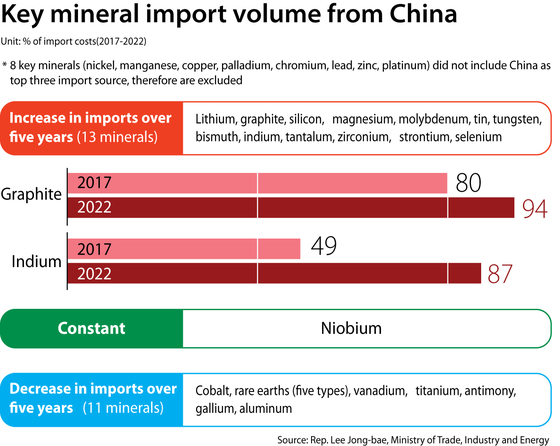Korea's reliance on China for minerals grows despite U.S. warnings
Published: 15 Oct. 2023, 07:00
Updated: 20 Oct. 2023, 18:28
-

- KIM JU-YEON
- kim.juyeon2@joongang.co.kr
![A notice announcing limited sales of urea posted Sept. 13, amidst rumors of a crisis in supply of Chinese sourced urea. [NEWS1]](https://koreajoongangdaily.joins.com/data/photo/2023/10/20/adf10e5d-f8cf-4d32-91a3-2e44f8a47153.jpg)
A notice announcing limited sales of urea posted Sept. 13, amidst rumors of a crisis in supply of Chinese sourced urea. [NEWS1]
Korea's dependence on China in securing key minerals has recently intensified despite repeated calls to curb the reliance due to uncertainties surrounding the Washington-Beijing row.
As of last year, 25 out of 33 imported strategic minerals hailed China as one of its three main sources, according to data compiled by the Ministry of Trade, Industry and Energy, received Wednesday by Rep. Lee Jong-Bae of the People Power Party (PPP).
The amount sourced from China for 13 goods, including lithium, graphite and tungsten, proportionally increased in 2022 compared to 2017. In particular, Korea’s import of graphite from China rose from 80 percent of its total imports in 2017 to 94 percent last year. China also accounted for 87 percent of Korea’s indium imports, up from 49 percent in 2017.
Korea is highly dependent on the United States and China for raw materials, including minerals, and components for the manufacturing sector, and as such keeps a precarious balance of diplomacy between the two economic giants. Calls for change were raised regarding the country’s dependency on China after a severe urea shortage in 2021 following Chinese export restrictions, and recently again after predictions of a reoccurrence arose.

It is not just minerals at stake. Out of 9,308 exported goods with sales over $10,000, 4,030 goods, or 43.3 percent, primarily came from China, according to the Korea International Trade Association (KITA). Some 2,113 goods, or 22.7 percent, were reliant on China for more than 70 percent of sourcing.
The steel, metal and chemical industries, which require large amounts of raw materials and battery components, were especially dependent on Chinese exports, with 40 to 50 percent of imports being primarily from China. “Sourcing from China remains a large supply chain risk, as China procures most of the supply of intermediate materials,” said Jang Sang-sik, head of trend analysis at KITA.
The supply channels for sourcing intermediate materials, components and equipment are limited too. For the 100 most used intermediate materials, components and equipment, the import rate sourced from China rose 5.9 percent, from 13.7 percent in 2017 to 19.6 percent this year July, according to PPP Rep. Han Moo-kyung’s data compilation. The increase in the purchase of Chinese exports was the largest compared to other major traders. This comes after export restrictions were implemented in 2019 to reduce reliance on imports from Japan.
Exiting China policy
The government is hastening supply chain diversification, such as in the import of minerals needed for battery production. One such strategy is the “Strategic Mineral Procurement Strategy” announced in February last year, aimed at mitigating reliance on key mineral imports from certain countries to a rate of 50 percent by 2030. This is due to heightened industrial barriers from countries wary of China, such as the U.S. Inflation Reduction Act and the European Union’s Critical Raw Materials Act.
However, China holds the world’s largest market share in 33 out of 55 key minerals and offers competitive prices. This makes it difficult to change trade sources.
“China offers the lowest priced raw materials, and the geographical proximity reduces logistic costs. Though the company faces risks, there is no choice but to largely source from China,” said an employee from a large enterprise.
“Souring relations between the United States and China means increasing problems for supply chains from China, but it takes time to actually lower reliance on Chinese goods,” added Kwak Sung-il, senior research fellow for the Korea Institute for International Economic Policy (KIEP).
![The United States and China are embroiled in rivalry in the semiconductor industry. [REUTERS]](https://koreajoongangdaily.joins.com/data/photo/2023/10/20/19fff425-c2f4-4533-9bbd-2632b0b6df5c.jpg)
The United States and China are embroiled in rivalry in the semiconductor industry. [REUTERS]
This is the reason why Korea, with key industries such as semiconductor manufacturing on the line, remains vulnerable to any movement from the Chinese government. From January to July this year, 90.2 percent of industrial elements used in vehicles were imported from China, despite attempts to veer trade toward the Middle East and Southeast Asia. If the China export ban is actually carried out, disarray is inevitable for the domestic transportation sector.
Too big to cut
China has been restricting the export of gallium and germanium, used in semiconductor manufacturing, since August in order to pressure the West. This is possible because of the country’s dominance in the market, accounting for 94 percent of the world’s gallium production and 83 percent of germanium production. It is more of a symbolic gesture of a “means of retaliation against sanctions” as of now, but there lies a constant risk of causing instability in supply and demand.
This risk is likely to recur in the future. For instance, the Chinese government is considering export controls for rare earths that are important for manufacturing electric vehicles. If China actually attempts to restrict exports, market prices are highly likely to soar.
Then Korea, which imported $640 million worth of rare earth permanent magnets last year alone, the largest amount to date, will inevitably suffer a blow. A recent report from KITA pointed out that “the stronger the pushback against China, the more China’s economic coercive measures, such as restricting exports of key minerals, could be expanded.”
![President Yoon Suk Yeol with Indonesian president Joko Widodo at a summit in Jakarta on Sept. 9. [REUTERS/YONHAP]](https://koreajoongangdaily.joins.com/data/photo/2023/10/20/341d4396-da32-49b3-986d-966feca5da57.jpg)
President Yoon Suk Yeol with Indonesian president Joko Widodo at a summit in Jakarta on Sept. 9. [REUTERS/YONHAP]
Pivot to Southeast Asia
Experts warn that there could be another reoccurrence of the urea shortage crisis in 2021. This is due to the unpredictability of problems that arise out of the U.S.-China conflict over high-tech industries, such as the U.S. Semiconductor Act, which restricts investment in semiconductors in China.
Korea, vulnerable to changes in global variables, and already weakened from high interest rates, exchange rates and oil prices, cannot expect a rebound in economic growth in the case of a supply chain disruption.
“There are concerns that the dependence on China for key minerals can harm the entirety of Korea’s industries, as experienced in the urea shortage crisis and retaliations against the Terminal High Altitude Area Defense,” said Rep. Lee Jong-bae. “As a second urea shortage crisis can occur at any time, it is necessary to quickly diversify import sources for risk mitigation and loss distribution strategies,” he added.
Critics say that supply chains should be expanded to Southeast Asia and Central Asia, coined “Altasia,” short for the alternative Asian supply chain. In practice, the volume of trade, including that of minerals, with such countries is gradually increasing. According to KITA, Vietnam is Korea’s sixth largest trading partner in terms of total domestic imports, with Malaysia (10th) and Indonesia (12th) also ranking highly.
Indonesia ranks first for nickel reserves and Uzbekistan seventh for tungsten reserves, showing large potential. The government has recently signed MOUs and TIPFs for cooperation on key mineral trade with Mongolia, Uzbekistan and Indonesia, in attempts to secure supply chains.
“The government should be more proactive in increasing supply chain partnerships with Southeast Asia and Central Asia. Companies should also join in [working with] these countries and lead bilateral cooperation,” said KIEP research fellow Kwak Sung-il.
“In order to reduce dependency on China, we have no choice but to increase cooperation with the U.S.-led Indo-Pacific Economic Framework, which consists of 14 member nations, for mineral supply chains. We should also join hands with Japan, which is ahead of the game in rare earths,” added Sagong Mok, supply chain management analyst at the Korea Institute for Industrial Economics and Trade.
![Escalators at Gwangmyeong Station start operating again after a year. The sign reads “Lift in operation after flood recovery.” [JOONGANG ILBO]](https://koreajoongangdaily.joins.com/data/photo/2023/10/20/e7a1f6d3-d4f2-4400-ab8d-3f6b2af0f5c5.jpg)
Escalators at Gwangmyeong Station start operating again after a year. The sign reads “Lift in operation after flood recovery.” [JOONGANG ILBO]
Escalator crisis
Problems arising from disruptions in Chinese supply chains are in many cases immediately tangible. In particular, they are felt through the mobility industry which deals with mobility equipment used by everyday users.
A number of escalators in Gwangmyeong Station only started running again recently, over a year since breaking down in July 2022 from heavy flooding. The difficulties in procuring components for urgent maintenance are regarded in the industry as the reason why.
For equipment used in the mobile industry, such as elevators, prices for imports from China are 30 percent cheaper than those produced in Korea, according to the industry. This means Korean products are not competitive and are often replaced by low-cost Chinese imports. Small- and medium-sized companies that do not have their own production facilities import products from Chinese manufacturers and have them installed.
All 2,640 escalators installed in stations under the supervision of Korea Railroad Corporation, as well as all 1,827 escalators installed in stations under Seoul Metro, were made with components imported from China, according to data compiled by PPP Rep. Kang Dae-sik.
The problem arises when urgent maintenance for equipment is required for the convenience and safety of its users, which can be stalled by supply chain disruptions. Most of the recent accidents caused by escalators installed on subways and railroads were identified as sites where Chinese components were imported and installed, including an incident in June this year, when an escalator in Sunae Station moved in reverse and injured 14 people.
“Industries that are essential to our daily lives need at least minimal protection measures in place,” said Jung Kwang-ho, professor at the Seoul National University Graduate School of Public Administration. “It is especially crucial in the public sector, which is directly connected to civil safety,” he added.
BY JEONG JONG-HUN, LEE WOO-RIM, LEE SOO-KI [kim.juyeon2@joongang.co.kr]










with the Korea JoongAng Daily
To write comments, please log in to one of the accounts.
Standards Board Policy (0/250자)